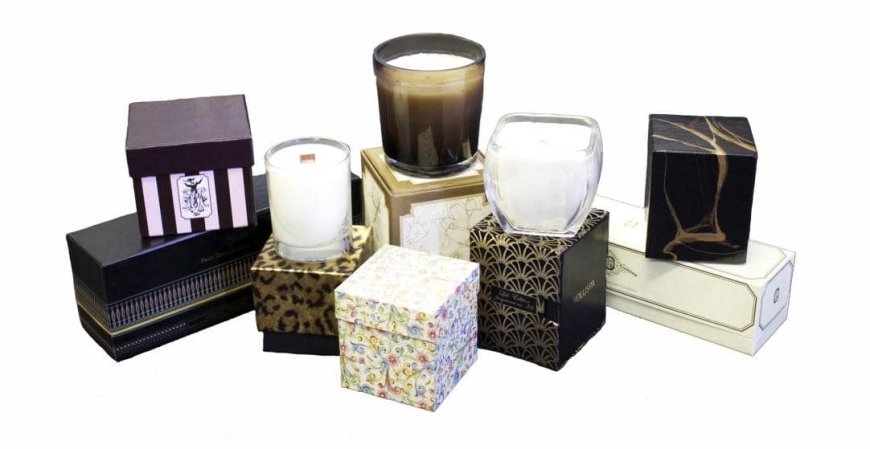Latest Trends in Candle Box Design Innovations
With more focus on sustainability and aesthetics, packaging plays a major role. Candle boxes are no longer just for protection—they help communicate the brand's story and values.

The candle industry has seen a big shift in how products are presented. With more focus on sustainability and aesthetics, packaging plays a major role. Candle boxes are no longer just for protection—they help communicate the brand's story and values.
Sustainable and Eco-Friendly Packaging
Eco-friendly packaging is no longer an option—it’s a necessity. Today’s consumers are more aware of environmental issues. They expect brands to make green choices in their product design. One major trend in candle box design is using biodegradable or recycled materials.
Many brands now use kraft paper or cardboard made from post-consumer waste. These materials reduce the need for virgin paper and cut down on deforestation. They are also easy to recycle. The production of eco-boxes also uses less energy and water. Some companies are even going a step further by using plant-based inks and glues. These natural components reduce chemical pollution.
Another growing practice is minimizing material usage. Instead of big and bulky packaging, brands are choosing slimmer and tighter-fitting custom candle box. These save space during shipping and reduce the overall carbon footprint. Compact packaging also appeals more to the modern consumer, who values simplicity.
Sustainable designs often feature earthy tones and raw textures. This natural look connects well with the eco-conscious buyer. Brands that invest in green packaging often receive positive attention online and through word of mouth. Consumers love to support companies that match their values.
Minimalist and Elegant Aesthetics
Minimalism continues to dominate the world of packaging. Candle boxes with clean lines, neutral colors, and subtle text are in high demand. The idea is to let the product speak for itself without too many distractions.
This design approach often features plain backgrounds and simple fonts. There might be a small logo or an elegant label. The goal is to create a calming and luxurious unboxing experience. Minimalist packaging also makes the product look more high-end. Many luxury candle brands have adopted this trend with great success.
Less clutter on the box allows the customer to focus on what really matters—the candle. It also provides a premium feel without the use of flashy graphics or bold patterns. This is perfect for buyers who value sophistication and quality over noise.
Color plays a key role in minimalist designs. Soft whites, warm beiges, and cool greys dominate this style. These colors not only look modern but also blend easily into various home settings. This is important since many buyers display their candles at home.
Using less design doesn’t mean the packaging lacks thought. In fact, it often takes more effort to create simple yet impactful packaging. Every element needs to be chosen with care. Typography, spacing, and material finish must all work together.
Artistic and Handcrafted Designs
In recent years, many candle makers have turned toward handcrafted and artistic packaging. These designs focus on individuality and creativity. This style often includes hand-drawn illustrations, watercolor patterns, or custom textures.
Artisanal designs stand out on shelves. They make each product feel personal and unique. These boxes appeal to consumers looking for something special. Buyers want to feel a connection to the product, and artistic packaging helps build that emotional link.
This trend is especially popular with small businesses and handmade candle brands. They often work with local artists to create custom box art. These efforts show care and attention to detail, which buyers appreciate. Even larger brands are beginning to include artistic touches in their packaging.
Textures also play an important role. Using rough paper or embossed surfaces adds a tactile element. It invites customers to touch and feel the box, creating a stronger bond with the product. The physical interaction adds to the overall experience.
Artistic candle boxes are great for gifting. A box that looks like a piece of art feels more thoughtful and valuable. This is important in a competitive market where gift-ready packaging can be a selling point.
Interactive and Functional Features
Designs with interactive and functional elements are gaining popularity. These features make candle boxes more than just packaging—they become part of the product experience. Examples include magnetic closures, reusable boxes, or even boxes that transform into holders.
A well-designed box with a magnetic lid adds elegance and practicality. It opens smoothly and closes securely. This enhances the feeling of quality and luxury. Many buyers keep these boxes for storage long after the candle is gone.
Some candle boxes are designed to fold into display stands. This helps in stores or homes where buyers want to show off their candles. Functional designs also support sustainability. Reusable boxes reduce waste and promote long-term use.
Adding windows to the box is another common feature. It allows customers to see the candle’s color, texture, or label without opening the package. This builds confidence in their purchase.
Interactive packaging can also include printed messages or QR codes inside. These can lead customers to a video about how the candle is made or suggest ways to reuse the box. It adds a digital touch to a physical product.
Nature-Inspired Themes and Colors
Nature has long been a source of inspiration for design. Today, more candle box designs are using colors, patterns, and textures found in the natural world. These boxes often feature floral prints, leaf patterns, or even stone and wood finishes.
Earthy color palettes are common—think greens, browns, creams, and sky blues. These colors give the box a calming and grounding feel. They also align well with candles that are marketed as natural, organic, or herbal.
Nature-inspired packaging connects with consumers seeking wellness and mindfulness. It creates a sense of peace, which matches the calming purpose of candles. The look and feel of the box prepare the mind before the candle is even lit.
Textures also mimic natural elements. For example, a matte finish may resemble stone, while a glossy surface can reflect water. These details help set the tone for the candle inside.
Nature themes are especially effective when paired with clean ingredients or botanical scents. When the packaging reflects the candle’s content, it creates a strong sense of unity.
Vintage and Retro Packaging Styles
Vintage styles are making a strong comeback in packaging design. Many candle boxes now reflect designs from the past, often using old-style fonts, faded colors, and classic patterns. This style taps into feelings of nostalgia and comfort.
Retro designs remind people of simpler times. They often reflect the 1920s to the 1970s, depending on the brand’s image. These boxes can feature muted color palettes, gold foils, and textured papers. All of these details create a rich, timeless look.
The appeal of vintage design lies in its warmth. It makes a product feel like a special keepsake. These boxes are often chosen as gifts or home decor pieces.
Typography plays a big role in this trend. Old-fashioned lettering styles add character and charm. Combined with simple illustrations or line art, the overall look becomes both classic and stylish.
Using a vintage approach also allows a brand to tell a story. It can hint at tradition, history, or long-standing quality. For example, a box may include a printed timeline or “established in” date to show legacy.
Transparent and Window Packaging
Transparency in packaging is another trend gaining ground. Candle boxes with windows or clear panels are attractive and informative. They let buyers see the candle without opening the box. This helps build trust and curiosity.
Transparent packaging often uses plastic or biodegradable films to create a peek-through section. This allows a view of the candle’s shape, color, or label. It is particularly effective for candles with unique colors, layers, or textures.
This design trend also works well in retail settings. Shoppers can instantly connect with the product visually. It reduces uncertainty and increases the chances of a sale.
Window packaging blends well with other design styles. For example, a minimalist box with a small window offers both elegance and practicality. It gives just enough view to attract attention without giving everything away.
This approach is also cost-effective. It adds visual appeal without needing extra graphics or text. The candle becomes the hero of the design. When a product is beautifully made, showing it off can be the best marketing.
Conclusion
Candle box design has evolved far beyond simple packaging. Today, it plays a vital role in how consumers connect with a brand and its values. Trends like sustainability, minimalism, artistic creativity, and functionality show that design is as important as the product itself. Whether it’s through eco-friendly materials, elegant simplicity, or premium finishes, each trend enhances the customer experience in a unique way. A well-designed box doesn’t just protect a candle—it tells a story, sparks emotion, and adds lasting value. As innovation continues, even a single detail, like a custom candle box, can make a powerful impression and turn an ordinary product into something memorable.








































































![https //g.co/recover for help [1-866-719-1006]](https://newsquo.com/uploads/images/202506/image_430x256_684949454da3e.jpg)


























![[PATREON EXCLUSIVE] The Power of No: How to Say It, Mean It, and Lead with It](https://tpgblog.com/wp-content/uploads/2025/06/just-say-no.jpg?#)






















































